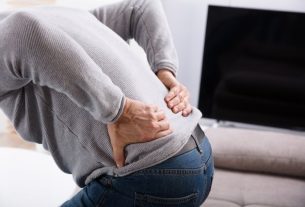Some muscle relaxing medications, such as carisoprodol, cyclobenzaprine or orphenadrine, may be recommended by the doctor for the treatment of muscle pain caused by muscle contractures, torticollis, fibromyalgia, low back pain or acute attacks of rheumatoid arthritis, for example.
These medications work by blocking nerve impulses or pain sensations that are sent to the brain that cause muscle contractions, spasms, or pain. In this way, they help to relax the muscles, facilitating movements and reducing acute pain.
Muscle relaxants generally have other substances in their composition, such as caffeine, paracetamol, dipyrone or diclofenac, which enhance the muscle relaxing effect, and should be used under medical advice, only by adults and for the duration of treatment established by the doctor.
Some muscle relaxing medication options are:
1. Carisoprodol
Carisoprodol is a muscle relaxant indicated for muscle pain in adults or adolescents over 14 years of age, caused by rheumatism, acute attacks of gout or rheumatoid arthritis, pain in the lumbar spine, or post-surgical pain.
This medicine is found in the form of tablets, generally in association with diclofenac sodium, paracetamol and caffeine, under the trade names Mioflex, Torsilax, Tandrilax, Beserol or Infralax.
How to drink: carisoprodol can be taken 2 to 3 times a day, always in a minimum dose and with an interval of 12 to 8 hours between doses, for a maximum of 10 days of treatment, or as advised by the doctor. Find out how to take carisoprodol correctly.
Who shouldn’t use: carisoprodol is contraindicated for pregnant or breastfeeding women, or for people who have high blood pressure, severe heart, liver or kidney failure. Furthermore, as it contains diclofenac in its composition, this remedy should not be used by people allergic to diclofenac or any other non-steroidal anti-inflammatory drug.
2. Cyclobenzaprine
Cyclobenzaprine hydrochloride is indicated for the treatment of muscle pain caused by torticollis, fibromyalgia, periarthritis in the shoulder, low back pain or pain that starts in the neck and radiates to the arm, for example.
This medicine is found in pharmacies or drugstores, in the form of tablets, with the trade names Miosan, Mitrul, Mirtax or Musculare, for example, or in generic form such as “cyclobenzaprine hydrochloride”.
Furthermore, there is another formulation that combines cyclobenzaprine hydrochloride with caffeine, which enhances the relaxing effect of cyclobenzaprine and can be found under the trade name Miosan Café.
How to drink: The normally recommended doses of cyclobenzaprine are 1 tablet of 5 or 10 mg, orally, 2 to 4 times a day, as advised by the doctor, for a maximum period of 2 to 3 weeks of treatment. See how to take cyclobenzaprine.
Who shouldn’t use: Cyclobenzaprine hydrochloride should not be used by children under 15 years of age, pregnant or breastfeeding women, people with glaucoma, urinary retention, hyperthyroidism, heart problems such as heart attack, congestive heart failure, arrhythmias or heart block.
3. Orphenadrine
Orphenadrine citrate is a muscle relaxant indicated for contractures, muscle sprains or strains, tension headaches, dislocations, muscle strains or torticollis.
This remedy is generally associated with dipyrone or paracetamol, which have analgesic action, and caffeine, which enhances the relaxing and anti-inflammatory effect, and can be found under the trade names Dorflex, Dorilax, Miorrelax, Doricin or Nevralgex, for example.
How to use: Orphenadrine doses depend on the composition of the tablet, and it is generally recommended to take 1 to 2 tablets, 2 to 4 times a day, as per medical advice. Learn how to take orphenadrine correctly.
Who shouldn’t use: Orphenadrine should not be used by children, pregnant or breastfeeding women, or by people who have glaucoma, stomach or intestinal obstruction, stomach ulcer, megaesophagus, prostate hypertrophy, myasthenia gravis or bladder neck obstruction, or heart problems . Furthermore, this medicine should not be used by people who are allergic to orphenadrine.
4. Baclofeno
Baclofen is a muscle relaxant indicated for the relief of pain or muscle stiffness caused by multiple sclerosis, bone marrow injuries, such as myelitis, or brain diseases, such as post-stroke, for example.
This medicine helps to relax muscles, relieve pain and improve movement capacity, carrying out daily activities and physiotherapy exercises, and should only be used with medical advice according to the condition being treated.
How to drink: The initial dose of baclofen for adults is generally 10 to 15 mg per day, divided into 3 or 4 times, which can be increased by the doctor every 3 days by another 15 mg daily, up to a maximum of 100 to 120 mg. See how to take baclofen correctly.
Who shouldn’t use: baclofen should not be used by people who are allergic to any of the components of the formula. Furthermore, it should be used with caution and only with a doctor’s guidance in pregnant or breastfeeding women or by people who have Parkinson’s disease, epilepsy, stomach ulcers, kidney problems, liver disease or diabetes.
5. Tizanidina
Tizanidine is a muscle relaxant indicated to relieve muscle spasms caused by disorders in the lumbar or cervical spine, after surgery for a herniated disc or hip osteoarthritis, or neurological disorders, such as multiple sclerosis, stroke or cerebral palsy, for example.
This medicine can be found in pharmacies or drugstores in its generic form, under the name “tizanidine hydrochloride”, or under the trade name Sirdalud, and should be used under medical advice, only by adults.
How to drink: Tizanidine doses vary according to the condition being treated, and the doctor may recommend a dose of 2 to 6 mg per day, divided into three doses, according to medical advice.
Who shouldn’t use: tizanidine should not be used by pregnant or breastfeeding women, or by people who have severe kidney failure or who are being treated with fluvoxamine or ciprofloxacin, for example.
6. Diazepam
Diazepam is a muscle relaxant from the benzodiazepine class that can be indicated for the relief of muscle spasm and severe muscle pain in cases of local trauma such as injury or inflammation, or for the treatment of muscle spasticity, as occurs in cerebral palsy and paralysis. legs, as well as in other diseases of the nervous system.
This medicine, in addition to relaxing muscles, is also used to treat anxiety and agitation and the doctor may therefore recommend it to sleep better. To sleep well, it is also important to know how to plan a good night’s sleep. See how to plan a good night’s sleep.
Diazepam is only sold upon presentation of a medical prescription and retention of the prescription by the pharmacy, found in its generic form or under the trade name Valium.
How to drink: The normally recommended doses of diazepam for adults are 5 to 10 mg per day, but depending on the severity of the symptoms, the doctor may increase the dose from 5 to 20 mg per day. Find out how to take diazepam.
Who shouldn’t use: diazepam should not be used by pregnant or breastfeeding women, or by people with severe respiratory or hepatic failure, sleep apnea syndrome, myasthenia gravis, or dependent on other drugs, including alcohol.
When to take medicine to relax your muscles
Remedies with a muscle relaxing effect should be used in periods of increased fatigue, when there is a lot of muscle tension or in cases of contractures with pain, torticollis or low back pain, for example.
However, these remedies should only be used as a last resort, for a short period of time, and always under the advice of a doctor. Furthermore, its use must be associated with regular physical exercise, which reduces the appearance of muscle contractures and daily stretching that helps to extend and lengthen the body’s muscles, especially important for those who work sitting.
Natural solution to relax your muscles
There are some natural ways that allow muscles to relax and that can be used to relieve muscle tension and pain, helping to treat contractures, torticollis, lower back pain or sprains.
A good natural remedy is to use a relaxing rosemary and lavender compress, which can be made using 1 drop of rosemary essential oil and 1 drop of lavender essential oil.
To make this compress, you must wet a towel with warm water and add drops of oil, and apply the compress to the affected muscle.
Furthermore, taking a very hot water bath, placing a hot water bottle on the painful area and doing local massages with relaxing essential oils such as bitter orange essential oil, are other tips that help alleviate muscle contractures, as they relieve the pain and help muscles relax.
It is important to highlight that natural ways to relax muscles do not replace treatment recommended by a doctor, and can be used to complement treatment with medication and/or physiotherapy.

Sign up for our newsletter and stay up to date with exclusive news
that can transform your routine!
Warning: Undefined array key "title" in /home/storelat/public_html/wp-content/plugins/link-whisper-premium/templates/frontend/related-posts.php on line 12
Warning: Undefined array key "title_tag" in /home/storelat/public_html/wp-content/plugins/link-whisper-premium/templates/frontend/related-posts.php on line 13




